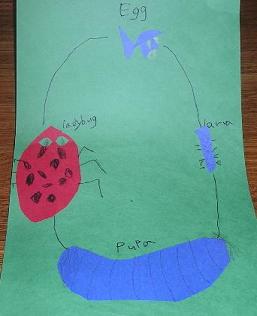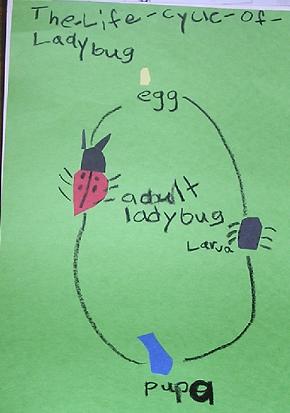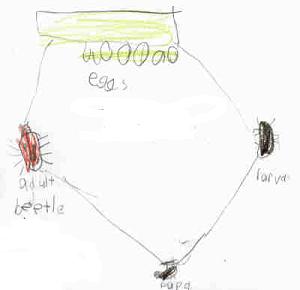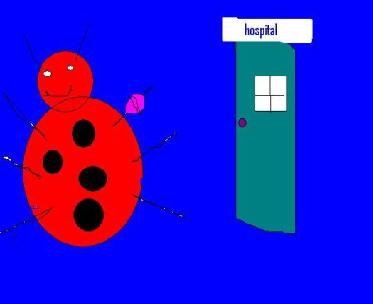|
Mrs.
McGowan’s First Grade
Ladybug Study
Ladybird Beetles
Red, tiny
Flying, crawling, munching
They eat many aphids.
Ladybugs!
Diamante Class Poem by Mrs. McGowan’s First grade 2008
~~~~~~~~~~~~~~~~~~~~~~~~~~~~~~~~~~~~
This year we began a new science unit on insects. We studied
mealworms, waxworms, crickets, silkworms, milkweed bugs,
butterflies and ladybugs. The ladybugs or ladybird beetle
larvae were kept in a little container with their food.
Only water had to be added to the habitat, a few drops at a
time.

We
kept a log to record their growth and how they seemed to change.
The larvae looked like little alligators!
Changing to pupae, they clung to the sides of the container for
a few days before emerging as tiny orange-colored beetles.
By the following day we could see the spots and the hard
shell was more red than orange.
In comparison to the butterfly life cycle, the ladybugs were
harder to see because of their size and they didn’t fly around
the container like the butterflies.
After a few days, the ladybugs were released on to a
flowering bush.
Although they were not as visually interesting as the
butterflies, our students learned several new facts about
ladybugs. We
had a good selection of books in the classroom and Internet
websites to use as resources.
|
Learning Objectives
|
Activities:
Choose 1 or more for each objective
|
|
Students will identify the four stages of the ladybug
life cycle
|
o
Show life cycle stages using Kidspiration interactive
chart on Smartboard
o
Draw and label a picture showing lifecycle
o
Make a lifecycle model
o
Dramatize the lifecycle
|
|
Students will know at least 4 important facts about
ladybugs
|
o
Tell about ladybugs
o
Write about ladybugs; make a list
|
|
o
Extension: Include ladybug (s) in a creative writing
piece
|
Paper models and drawing of ladybug lifecycle
|
Matthew

|
Nicholas

|
|
 by
Jack B. by
Jack B.
|
All of the children created a story about an imaginary butterfly
and some chose to publish their writing. Fiona’s story was
planned with a 4-square organizer.
She illustrated it in Paint.
|

|
Jakaroo
by Fiona
Jakaroo the ladybug is as weird as my three brothers.
It is her first day of school. She broke her arm
by falling off a house and she had to go to the hospital
to get a cast.
Her mom and Dad were so worried that they started crying
too. After
two weeks, she got better and was fine.
|
|
Buster
by Matthew
One day a ladybug named Buster went to his friend Bob
the frog’s house.
It was his first time.
Buster did not know that a spider lived there
too. It took a while to get there because the sidewalk
was so big.
Finally Buster was there.
The spider opened the door and got him!
But the frog was watching and ate the spider.
Buster was FREE!
|
Kaite
by Lily

|
Kaite was a
beautiful ladybug.
One time, she went to the New York beach.
Kaite wanted to go into the ocean.
Kaite said the ocean was the coolest thing she
had ever done.
She wanted to do it again and again and again.
WOW!
When Kaite went out into the ocean, she went too
far away from me.
She got lost in the ocean.
Oh, no!
When she floated away, I swam after her.
Then I finally got her.
We lay on the beach together.
It was a great day!
|
A final assessment was done with each student using a
Kidspiration template.
The talking interface was available. This is a very simple drag
and drop activity that shows how alternative assessment can be
done on the computer.

You can download this
Kidspiration file:
RESOURCES
* Books we used:
Insects - Delta
Education
Beetles – Claire Llewellyn
The Best Book of Bugs - Claire Llewellyn
Ladybugs - Margaret Hall
Ladybugs: Red, Fiery, and Bright -
Mia Posada
*The curriculum materials included with this project were so
helpful and interesting.
Thanks to all the story writers and online activity
creators!
*These sites also were helpful to our study:
http://webtech.kennesaw.edu/jcheek3/ladybugs.htm
http://www.geocities.com/sseagraves/schoolyardscience.htm
|

